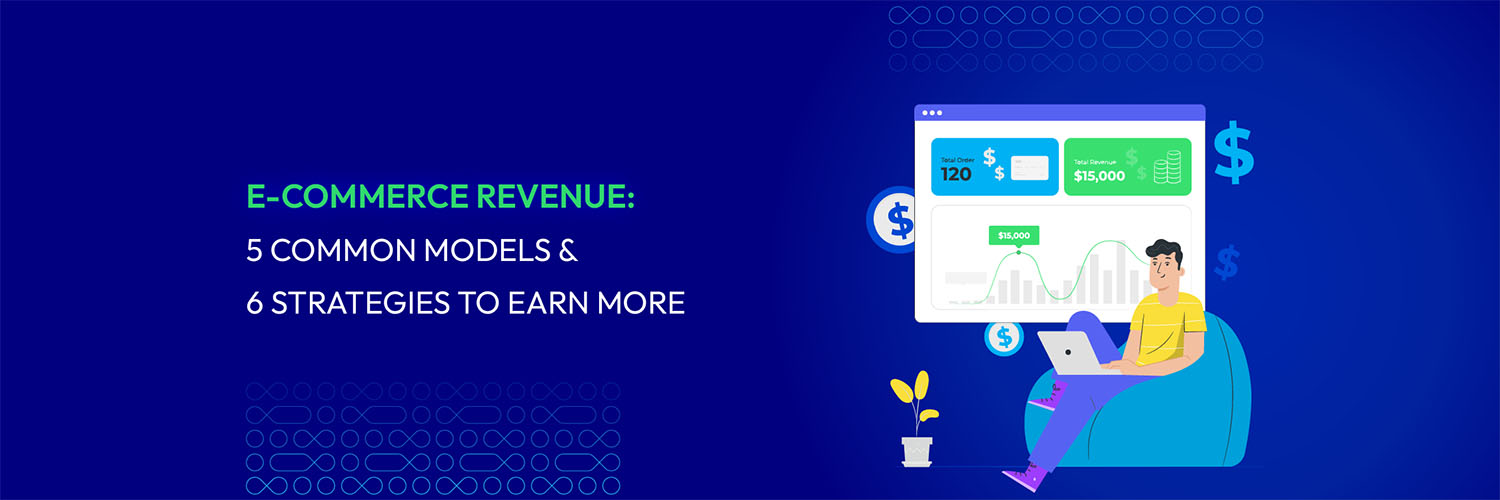E-commerce Revenue: 5 Common Models & 6 Strategies to Earn More
Summer Nguyen | 08-22-2023

The global e-commerce market has witnessed remarkable growth, with Statista reporting revenue surpassing 5.7 trillion U.S. dollars in 2022. This substantial figure underscores the industry’s immense potential for further expansion in the coming years.
E-commerce revenue is a critical indicator of an e-commerce business’s performance and growth. It represents the total monetary value obtained by a company through online transactions with its customers. Various revenue models generate income from online transactions, including advertising, subscription, transaction fee, affiliate, and freemium models.
This article discusses the sales revenue model in e-commerce, which involves selling goods or services directly to customers to earn a profit margin. Additionally, we will examine the principles of e-commerce revenue recognition, which entail the rules and standards governing the reporting of e-commerce revenue in financial statements.
What is E-commerce revenue?
E-commerce revenue is the total money generated through online sales and transactions within an electronic commerce (e-commerce) business. It represents the financial income derived from purchasing products or services made by customers through online platforms or websites.

Tracking and analyzing e-commerce metrics is crucial for businesses as it helps measure the effectiveness of marketing strategies, assess product performance, understand customer behavior, and make informed business decisions. By monitoring and optimizing e-commerce revenue, businesses can enhance profitability, drive growth, and improve their overall online business operations.
E-commerce Solution Provider
Over 119,000 global clients have achieved their goals with Mageplaza's help. It's your opportunity to do the same now!
Get Started5 E-commerce revenue models to grow your business
In the dynamic world of e-commerce, businesses constantly seek innovative ways to generate revenue and drive sustainable growth. A key aspect of success lies in adopting effective revenue models tailored to specific business objectives.
Online Advertising
In online advertising, companies allocate funds to showcase their advertisements on websites, search engines, and social media platforms. Advertisers can select from diverse targeting options, including demographics, interests, or specific keywords, to reach their intended audience effectively.

Google Ads is a highly utilized online advertising platform where businesses engage in keyword bidding relevant to their offerings. Consequently, their advertisements are showcased to users searching for those keywords on Google. Google generates revenue by charging businesses for every click received on their advertisements.
Advantages
-
Wide reach: Online advertising allows businesses to reach a broad and diverse audience, transcending geographical boundaries and accessing a global market.
-
Cost-effective: Businesses can set their advertising budget and pay only when users interact with their ads, such as by clicking on them or taking desired actions. The pay-per-click or pay-per-action approach in online advertising provides businesses with a cost-effective choice, regardless of their size.
-
Measurable results: Businesses gain valuable insights into the performance of their advertisements through online advertising, utilizing metrics such as impressions, clicks, conversions, and engagement rates. This data empowers businesses to evaluate the effectiveness of their campaigns and make informed decisions to enhance their advertising strategies based on real-time analytics.
Disadvantages
-
Ad blocking: Some users employ ad-blocking software, preventing the display of online ads. This reduces the visibility and effectiveness of advertisements, potentially limiting the reach and impact of online advertising efforts.
-
Competition: The online advertising landscape is highly competitive, with numerous businesses vying for user attention. This requires businesses to develop compelling ad creatives, target the right audience, and employ effective strategies to stand out amidst the fierce competition.
-
Ad fatigue: With the abundance of online ads, users may become overwhelmed and desensitized to advertising messages. This can lead to lower engagement rates and diminishing returns on advertising investments, necessitating businesses to continually innovate and create captivating ad experiences.
-
Ad fraud: Online advertising is susceptible to fraudulent activities, such as click fraud, where illegitimate clicks or impressions are generated to exhaust advertising budgets without genuine user engagement. Businesses need to implement robust fraud detection measures and work with reliable advertising platforms to mitigate the risk of ad fraud and protect their advertising investments.
Transaction Fees
Transaction fees are a prevalent revenue model e-commerce platforms employ to generate income. When a transaction occurs on the platform, whether it involves purchasing a product, a service, or any other online transaction, the platform charges a certain percentage or a fixed fee. This fee is applied to the total transaction amount, and the platform deducts it before disbursing the remaining funds to the seller or service provider.
Etsy, an e-commerce platform specializing in handmade and vintage products, implements a fee structure for sellers. Each seller is subject to a listing fee for each item listed on the platform and a transaction fee based on the final sale price of the item. Etsy generates revenue by collecting these transaction fees from sellers utilizing its marketplace.
Advantages
-
Revenue generation: Transaction fees serve as a direct and reliable source of revenue for e-commerce platforms, contributing to their financial sustainability and growth.
-
Scalability: As the volume of transactions increases, the revenue potential from transaction fees also grows, allowing e-commerce platforms to scale their operations and expand their services.
-
Shared risk: Transaction fees help mitigate the risk associated with inventory management and fulfillment for businesses utilizing the platform. By transferring these responsibilities to the platform, businesses can focus on their core operations while sharing the risk burden.
Disadvantages
-
Profit dependency: E-commerce businesses that rely solely on transaction fees may face challenges during periods of low transaction volume, potentially impacting their profitability and financial stability.
-
Customer perception: Some customers may be deterred by transaction fees and prefer platforms that offer lower or no fees. It is essential for e-commerce platforms to carefully consider customer preferences and find a balance between fees and value propositions.
-
Cost transparency: Communicating transaction fees to customers is crucial to avoid potential dissatisfaction or disputes. Clear information about the fees upfront helps build trust and maintain positive customer relationships.
-
Balancing competitiveness and profitability: Setting transaction fees at a competitive level while ensuring profitability can be a delicate balancing act. E-commerce platforms need to analyze market dynamics, competition, and cost structures to balance attracting customers and maintaining profitability.
Product and Information Sales
Product and information sales in e-commerce involve businesses selling their products or valuable information directly to customers through their dedicated online platforms. This model grants businesses control over inventory management, order fulfillment, and customer support.
A prime example of success in this model is Amazon, the world’s largest e-commerce company, which generates substantial revenue by directly selling a vast range of products to customers through its platform. By leveraging efficient logistics infrastructure and robust customer service, Amazon has solidified its position as a leader in the industry.
Advantages
-
Profit margin control: Direct sales give businesses complete control over pricing and profit margins, making financial management more efficient.
-
Brand loyalty and customer relationships: By engaging in direct sales, businesses can establish stronger customer relationships, foster brand loyalty, and create a loyal customer base.
-
Diversification: Offering a diverse range of products or information through direct sales helps businesses diversify their revenue streams and cater to different customer segments, reducing dependence on a single product or market.
-
Upselling and cross-selling opportunities: Direct sales enable businesses to offer customers related products or services, increasing transaction values and revenue through upselling and cross-selling.
Disadvantages
-
Inventory management: Managing inventory, particularly for physical products, can be challenging and resource-intensive. Businesses must ensure accurate stock management to meet customer demands while minimizing excess inventory.
-
Fulfillment and logistics: Ensuring timely delivery and managing customer expectations for product shipments require efficient logistics operations. Businesses must have robust fulfillment systems to provide a seamless customer experience.
-
Customer acquisition costs: Acquiring new customers for direct sales may involve substantial marketing investments and implementing customer acquisition strategies. Businesses need to allocate resources for customer acquisition campaigns to drive growth.
-
Competitive pricing: With increased price transparency in the e-commerce landscape, businesses engaged in direct sales face the challenge of competing with other e-commerce enterprises on pricing. Maintaining competitive prices while ensuring profitability requires careful pricing strategies and market analysis.
Membership Revenue Model
The membership revenue model is a business model that generates revenue by charging customers a recurring fee to access a product or service.

This model benefits both customers and companies, as customers enjoy convenience and value, while companies enjoy predictable revenue and customer loyalty.
The membership revenue model is suitable for businesses that provide ongoing access to content, such as video, music, books, or membership sites, or companies that offer personalized services, such as fitness, wellness, or education.
Some examples of successful businesses that use the membership revenue model are Netflix, Spotify, Amazon Prime, Massage LuXe International, and Paddle.
Advantages
-
Recurring Revenue: The Membership Revenue Model offers a steady recurring revenue stream. Businesses can ensure a predictable cash flow by charging customers a regular membership fee, contributing to financial stability and long-term planning.
-
Customer Loyalty: When customers become members, they often develop a sense of loyalty toward the business. One way to improve customer retention rates is by increasing users’ likelihood to continue to use the services and renew their membership. This loyalty can also lead to positive word-of-mouth referrals and recommendations.
-
Enhanced Customer Relationships: Membership models allow businesses to build stronger relationships with their customers. By offering unique privileges, customized interactions, and individualized perks, companies can foster a feeling of belonging and deliver extra benefits to their members. By using this method, it’s possible to enhance customer engagement and satisfaction.
-
Upselling and Cross-selling Opportunities: By using membership models, you can offer customers the chance to purchase more products or services through upselling and cross-selling. By offering exclusive upgrades or add-ons to members, businesses can increase their average revenue per customer and drive other sales.
Disadvantages
-
Initial Customer Acquisition Costs: Acquiring new members can be costly, especially when considering marketing and promotional activities to attract potential customers. The investment required to acquire a significant number of members can impact the business’s profitability, particularly in the early stages.
-
Member Churn: Retaining members can be challenging, primarily if the value provided fails to meet their expectations. If members feel that the benefits or services are not worth the cost, they may cancel their membership, leading to a loss in recurring revenue. Businesses must continually focus on delivering value and addressing member needs to minimize churn.
-
Limited Market Size: Membership models may have a limited market size, depending on the target audience and the nature of the services offered. Not all customers may be willing to pay for a membership, and the potential market may be constrained to a specific niche or demographic.
-
Risk of Competition: As membership models become more popular, the risk of competition increases. Other businesses may enter the market and offer similar or alternative membership options, which can lead to price competition or dilution of the value proposition.
Affiliate Revenue Model
The affiliate revenue model works by allowing the affiliate to sell other people’s products or services without creating, producing, or delivering them.
The affiliate’s role involves directing their website visitors to the products or services, and they receive a commission when those visitors make a purchase. This is very similar to traditional offline advertising methods like newspaper ads or television commercials.
The affiliate revenue model can be based on payment methods, such as pay-per-click, pay-per-impression, pay-per-lead, or pay-per-sale.
Advantages
-
Low cost and risk: The affiliate revenue model enables the affiliate to start and run a business with minimal cost and risk. Unlike the seller, the affiliate is not responsible for creating, producing, or delivering the product or service. The affiliate also does not have to deal with inventory, fulfillment, customer service, or warranty issues. The affiliate only pays for the marketing and promotion costs, which can be low or even free, depending on the methods used.
-
High flexibility and diversity: In the affiliate revenue model, affiliates can select from various products or services to promote that match their interests and specialization. The affiliate can also diversify their income streams by promoting multiple products or services from different sellers. The affiliate can adjust its marketing and promotion strategies according to the market demand and customer feedback.
-
High scalability and profitability: The affiliate revenue model enables the affiliate to scale their business without increasing costs proportionally. Utilizing the internet and technology, affiliates can effortlessly reach a vast and global audience. The affiliate can also increase their profit margin by choosing high-commission products or services and optimizing their conversion rates.
Disadvantages
-
Low control and quality: The affiliate revenue model involves a loss of control over the product or service and its delivery. Affiliates depend on sellers to uphold the quality and consistency of their products or services, fulfill customer expectations, and meet deadlines. Additionally, affiliates must adhere to the terms and conditions set by the seller and the affiliate network, which may not always align with their personal goals and values.
-
High competition and saturation: The affiliate revenue model faces increased competition from affiliates offering similar or identical products or services. Affiliates must find distinctive ways to differentiate themselves and cultivate a loyal customer base to thrive. The affiliate also has to deal with the risk of saturation, which means that the product or service becomes too familiar or outdated in the market and loses its value and appeal.
6 strategies to rocket your E-commerce revenue
1. Optimize your e-commerce store for mobile users
In the present digital era, it is crucial to optimize for mobile devices. Online shopping through smartphones is becoming more prevalent.

Businesses must ensure their e-commerce store is responsive and provides a seamless user experience on mobile devices. This optimization can lead to higher conversion rates, improved customer satisfaction, and increased revenue.
As stated by Statista, within the last six months, almost 80% of smartphone users in the U.S. have used their mobile device to make an online purchase., and the retail e-commerce sales in the U.S. reached 343 billion USD in 2019.
2. Give emphasis on the best products:
Identifying and emphasizing your best-selling or high-margin products is essential for driving revenue.
By showcasing these products prominently on your website, you can capture customers’ attention and increase their likelihood of purchasing. Highlighting their unique features, offering special deals or discounts, and displaying positive customer reviews can further enhance their appeal.
In accordance with UNCTAD, the most popular products purchased online worldwide are fashion and beauty products; consumer electronics; toys, hobbies, and DIY; furniture and appliances; and food and personal care.
3. Look from customers’ perspective:
Taking a customer-centric approach is crucial for e-commerce success.
By understanding your customers’ needs, preferences, and pain points, you can tailor your website, product offerings, and overall shopping experience to meet their expectations.
This customer-centric focus can lead to increased customer satisfaction, repeat purchases, and positive word-of-mouth referrals.
Based on UNCTAD, in 2019, the largest e-commerce market in the world was China, with a value of 1.5 trillion U.S. dollars, followed by the U.S. with 86 billion U.S. dollars.
4. Offer as many payment options as possible
Providing multiple payment options is essential for accommodating customers’ preferences and increasing conversion rates. Accepting credit/debit cards, digital wallets, and alternative payment methods ensures convenience and flexibility for customers.

Multiple payment options can reduce friction during checkout and improve overall customer satisfaction.
According to Statista, the most popular payment methods for online shopping worldwide in 2021 were digital wallets (49%), credit cards (21%) and debit cards (13%).
5. Add free shipping
Providing free shipping can be a strong motivator for customers to finish their transactions.
It eliminates an additional cost barrier and can increase the perceived value of the products.
Implementing free shipping, either universally or through order thresholds, can drive higher order values, reduce cart abandonment rates, and attract more customers.
6. Go through A/B testing
A/B testing is a technique that involves comparing two versions of a webpage or element to determine which one produces more favorable results in terms of conversion rates.
By conducting A/B tests on various aspects of your e-commerce store, such as design, layout, copywriting, or call-to-action buttons, you can gather data-driven insights to optimize your website for maximum conversions.
This iterative testing approach helps you make informed decisions and continuously improve your website’s performance.
Read more: 9 Ecommerce Marketing Strategies to Maximize Your Online Sales
Conclusion
Every business strives to achieve revenue goals, but the ultimate objective is to generate profit. To maximize profit, it is crucial for companies to possess a comprehensive understanding of the E-commerce revenue model and strategies.
Additionally, resilience and perseverance are key qualities that businesses need to overcome challenges and setbacks. By embracing these attributes and employing successful revenue strategies, businesses can position themselves for triumph and attain their profit goals in the ever-changing realm of E-commerce.







![Top 20+ Must-have Shopify Apps for 2025 [Free & Paid] - Mageplaza](https://cdn2.mageplaza.com/media/blog/must-have-shopify-apps/top-must-have-shopify-apps.png)
![[2025 Updates] Top 10+ Upsell Apps for Shopify - Mageplaza](https://cdn2.mageplaza.com/media/blog/best-upsell-shopify-app/cover.png)